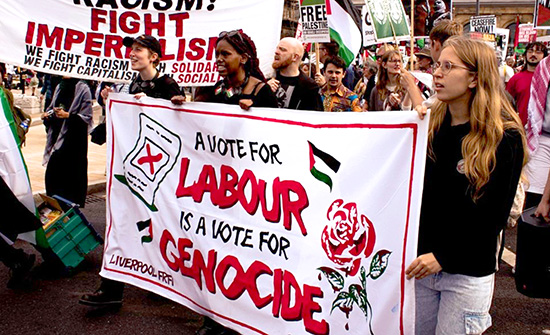Since Labour ministers announced in August their supposed discovery of a ‘black hole’ in public finances left by the outgoing Tory government, Prime Minister Keir Starmer and the Chancellor Rachel Reeves have set a gloomy tone for the new government’s agenda, warning that ‘painful decisions’ lie ahead in order to reduce government borrowing. Far from a promised ‘decade of renewal’, this heralds a renewed onslaught on working class living standards. Labour has already pledged to scrap Winter Fuel Payments to most pensioners and axe planned investments in hospitals, rail and roadbuilding. But this is only the beginning. The 30 October Autumn Budget statement is expected to announce tax rises and new cuts to public spending – a continuation and deepening of Tory austerity. Whether the Labour government can carry out this brutal programme depends on whether the trade unions and opportunist left can keep working class resistance under control as they did throughout the Tory years. Will Jones reports.
Black holes and revelations
On 8 July, the new Labour Treasury began an ‘audit’ into the state of the public finances; it published the results on 2 August, revealing a forecast £21.9bn overspend in departmental spending, beyond the limit set by the Treasury in the Spring Budget 2024. The Treasury immediately announced £5.5bn of planned savings. These included cutting Winter Fuel Payments to pensioners who are not in receipt of Pension Credit and certain other means-tested benefits, cancelling plans to scrap social care charges for older people and cancelling rail and roadbuilding projects. The Treasury is also reviewing plans to build 40 new hospitals. The cut to Winter Fuel Payments would reduce spending by £1.5bn. Payments of around £200-£300 went to 10.8 million pensioners last winter – this winter, just 1.5 million will receive the payments.
Former Tory Chancellor Jeremy Hunt accuses the Labour government of inventing a hole in the public finances to shift blame onto the Tories for the pain that is about to be inflicted. But as Paul Johnson, the director of the Institute for Fiscal Studies, wrote on 4 August, ‘the £22bn “black hole” was obvious to anyone who dared to look… there was always going to be a hole here. The only question was how big.’ In June, before the General Election, Johnson had already accused both Labour and Tories of a ‘conspiracy of silence’ over the state of public finances.
Britain’s vulnerability to a fiscal crisis is not a new discovery. In the financial year 2022-23, Britain paid interest of £111bn on the national debt, a record amount since World War II, more than on education. On 20 September the Office for National Statistics (ONS) published figures showing that, for the first time since 1961, government debt now stood at 100% of GDP after rising 4.3 percentage points in the year to August 2024. This means that Britain’s national debt is equal to the value of all goods and services produced in a year. The Office for Budget Responsibility has projected that, due to an ageing population and climate change, Britain’s public debt could be on a ‘permanent upward trajectory’ and could reach 270% of GDP by 2070 unless drastic changes are made to improve economic productivity, improve population health and limit global heating. If economic shocks are factored in, this rises to over 300% of GDP. Without significant economic growth and consequently higher tax returns, the government must print money in order to service the debt, threatening the value of the pound.
The Labour government already committed before the election to follow the fiscal rules established by the Tories in November 2022 to restrict government borrowing. The primary rule is that borrowing must be lower as a share of national income at the end of financial year 2028/29 than it is at the end of 2027/28. This leaves very little room for manoeuvre. After announcing the initial £5.5bn of spending cuts in August, the Treasury warned, ‘this is a significant downpayment, but these decisions alone will not be sufficient. The government is setting out further steps to tackle the spending pressures that remain and to take the difficult decisions necessary to secure the public finances. These decisions will be set out in the Budget on 30 October.’
Death by a thousand cuts
More than £30bn was slashed from benefits and public services by the Tories and Lib Dems over the course of the 2010-2019 austerity programme; benefits have never been restored to their paltry 2010 levels, and the cruellest measures of Tory Chancellor George Osborne’s programme all remain in place:
- Introduced as part of the Welfare Reform Act 2012, the ‘bedroom tax’ penalises social housing tenants for having ‘spare’ rooms in their houses by reducing their Housing Benefit by 14% of the eligible rent for one spare room, and by 25% for two or more. This was to force poor people into more cramped accommodation.
- The overall benefit cap, introduced in 2013, limited the amount of benefits a working-age household can receive to £26,000 per year for a couple or household with children/£18,200 for a single person. Despite inflation, the cap is now lower at £25,323/£16,967 in London and £22,020/£14,753 elsewhere.
- The two-child benefit cap, introduced in 2017, limits benefits received by most households to two children. To abolish this today would immediately lift 300,000 children out of poverty and a further 700,000 out of extreme poverty.
The Labour Party throughout this period did not oppose Tory austerity measures, and under Jeremy Corbyn and John McDonnell’s leadership from 2015-2019, Labour-run councils were instructed to implement austerity budgets in compliance with Whitehall diktat. The trade unions never mounted any meaningful resistance to benefit cuts. The consequences were devastating for poor, elderly and disabled people. Research by the London School of Economics published in June this year found that the austerity programme: ‘cost the average person nearly half a year in life expectancy between 2010 and 2019. Regional disparities in life expectancy across Britain also widened. Overall, austerity measures resulted in about 190,000 excess deaths, or a 3% increase in mortality rates, from 2010 to 2019, including many “deaths of despair”.’
Party poopers
Labour MPs, many of whom won their election contests by small margins, are anxious that more of the ‘A-word’ would make the new government immediately unpopular. But added to their protests are warnings that tight fiscal rules and cuts to public spending could choke off economic growth rather than stimulate it. In a letter to the Financial Times on 16 September, eight economists argued that ‘under-investment is a central cause of the UK’s poor recent economic performance and the root of many of the problems we now face as a country…the government has inherited spending plans that imply substantial real-terms cuts in public investment over the current parliament. We do not see how the planned “decade of national renewal” can take place if these cuts are delivered.’
On 20 September, the same day the ONS published its stark public debt figures, market research institute GfK released figures showing that, even as the Christmas consumption season approaches, consumer confidence (a measure of how much money households expect to spend on consumer goods in the future) had fallen to its lowest level since March, when the Tory government was in its death throes and the economy had barely scraped out of a technical recession. GfK’s Neil Bellamy was clear that Starmer and Reeves were responsible for this doom and gloom: ‘Following the withdrawal of the winter fuel payments, and clear warnings of further difficult decisions to come on tax, spending and welfare, consumers are nervously awaiting the budget decisions on 30 October.’
So as the Labour Party Conference in Liverpool got underway, Starmer reassured ‘We are not going down the road of austerity’ in an interview published by the Sunday Mirror on 22 September. Echoing this in her speech to the Conference on 23 September, Reeves promised ‘there will be no return to austerity’. This may have comforted the assembled labour aristocrats who represent relatively well-off public sector workers, but not the millions of people in Britain for whom austerity never went away and whom the Labour Party and its union backers do not represent.
When a non-binding motion opposing the cuts to Winter Fuel Payments was unexpectedly relegated to the ‘graveyard slot’ on the final day of the Labour Conference, when many trade union delegates would be absent, unions howled that they would not be able to express their opposition through this symbolic vote. But Labour Conference is merely a theatre of democracy, and at the same time a carnival for the rich: 500 tickets for ‘business day’, going for £3,000 each, reportedly sold out in minutes as the bourgeoisie flocked to hear what Labour would offer them; ‘the corporate equivalent of going to Glastonbury’ said one executive attendee.
The symbolic motion against the Fuel Payments cut was passed, yet these theatrics only serve to conceal the reality of Labour’s rulings in Parliament: on 23 July, 361 Labour MPs had voted against a real parliamentary motion that would have ended the two-child benefit cap (see ‘Scrap the two-child benefit cap’, FRFI 301); nine Labour MPs abstained or were absent, and seven who voted against were suspended from the party. Such punishments for what little remains of the Labour ‘left’ ensure iron discipline as Labour continues its war on the poor. Thus, at the actual vote to cut Winter Fuel Payments on 10 September, the government won the vote by 348 to 228 votes – this time only one MP with the Labour whip, Jon Trickett, opposed it.
Not only has Labour not promised to maintain spending across all government departments, let alone funding for local government services; it will not restore benefits to the levels they were at before austerity, nor repeal any of the aforementioned draconian policies inflicted on the poorest households, which force the poorest people into the worst kinds of insecure employment and into debt in order to escape starvation. Instead, Starmer, echoing the architect of austerity George Osborne, used his Conference speech to promise that Labour would ‘do everything we can to tackle worklessness’ by cracking down on ‘benefit fraud’ in order to scrape back £1.6bn from claimants and force the long-term sick into work. In reality, the total amount of benefits that are unclaimed in Britain is estimated at £24bn per year according to Policy in Practice, due to lack of public awareness of people’s rights, deliberate bureaucratic obstacles and, of course, social stigma of the kind stoked up by Labour politicians and the media. Such are the ruling class’s cheapest available means to improve Britain’s miserably sluggish economic productivity.
One government department that Labour has assured will get a healthy boost in spending is the Department of ‘Defence’. Labour committed before the election to raise military spending to 2.5% of Britain’s GDP (£61bn at current levels) as soon as possible, which is 0.5% in excess of the target set by NATO for its member states. As the Labour government gears up for war on the working class both here and abroad, it is urgent that we build the resistance through working class solidarity.
FIGHT RACISM! FIGHT IMPERIALISM! 302 October/November 2024




